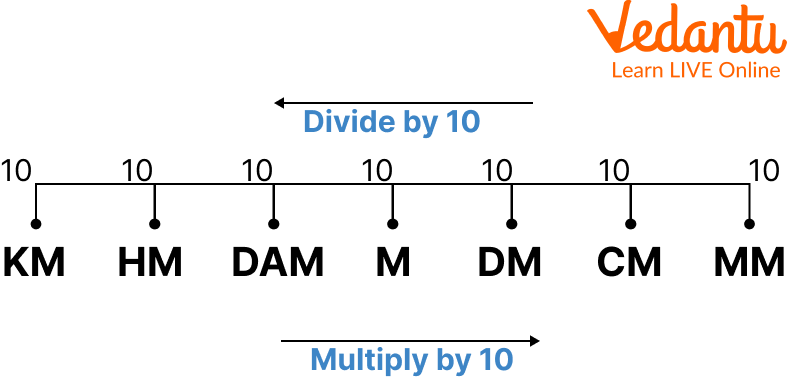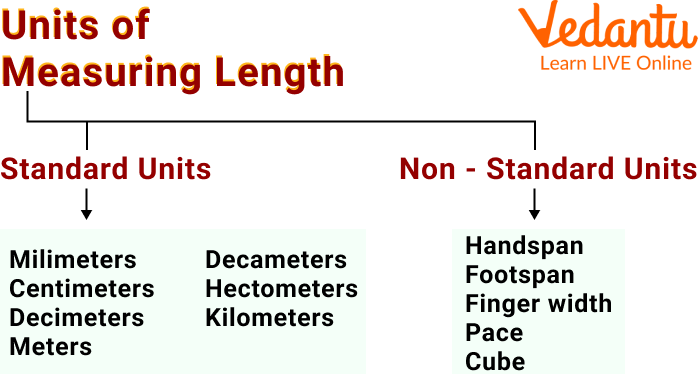




Common Units and Conversion Table for Length Measurements
Measuring length involves measuring the length of any object using measuring tools such as a ruler, measuring tape, and so on. A ruler, for example, can be used to measure the length of a pencil in inches. A foot scale can be used to measure the height of students in a class. Inches, centimetres, metres, feet, and more length units exist. The act of measuring the length of things in some specified units, which can be standard or non-standard, is defined as length measurement. Here, we will learn about length units of length, meters conversion chart and will also see the unit conversion chart.
How to Measure Length?
A ruler has two sides: centimeters/millimeters and inches. The following are the steps for measuring length with a ruler:
Step 1: Select the unit of measurement for length. If you want a value in centimetres, use the ruler's centimetre side. If the measurement is in inches, use the ruler's inches side.
Step 2: Place the object beside the ruler, beginning at point 0.
Step 3: Read the endpoint and record the value.

Measure Length
Units of Length
Length can be measured in several measures such as centimetres, inches, metres, and so on. The length measurement units are divided into two types: Standard length measuring units and non-standard length measuring. Below is the image showing units of measurement chart.

Measurement chart
Standard and Non Standard Units of Measuring Length
Standard units are pre-defined and do not vary from person to person or object to object. If two or more people measure the same object's length in any standard unit, say inches, they will receive the same measurement. Meters, millimetres, inches, feet, yards, are some of the examples of it.
Non standard units do not have a defined numerical measurement. They differ from one person to the next and from one thing to the next. For example, if a youngster and his father use their handspan to measure the length of a rectangular wall, they are likely to get different results. This is because a child's handspan is typically smaller than that of an adult.
SI Unit of Length
The SI unit of length measurement is the metre (m). The metre is the basic unit of length, as indicated in the measurement chart. Its equivalent in other units is provided below:
$1 \mathrm{~m}=100 \mathrm{~cm}$
$1 \mathrm{~m}=1000 \mathrm{~mm}$
$1 \mathrm{~m}=0.001 \mathrm{~km}$
$1 \mathrm{~m}=39.37 \text { inches }$
$1 \mathrm{~m}=1.09361 \text { yards }$
$1 \mathrm{~m}=3.28 \text { feet }$
Measurement of Length Chart
The length measurement chart makes it simple to convert one unit to another. For example in the case, if we know that one yard equals 36 inches, we can easily convert three yards to inches by multiplying three by 36.
Let’s see the measurement table in which we will unit conversion chart:
Solved Example
Q 1. $6000 \mathrm{~mL}$ equals how many litres?
Ans: Since, to convert from milliliters to liters, always multiply the number or figure by 0.001 (or divide by 1000).
Here, we have 6000mL given.
So we will divide it by 1000. i.e. $\frac{6000}{1000}$
On solving it, we get
= 6L
Hence, $6000 \mathrm{~mL}$ equals to 6 L.
Q 2. Convert 3 kilometers to meters.
Ans: Since, we know that 1 km = 1000m
Therefore, $3 \mathrm{~km}=3 \mathrm{~km} \times 1000$
$=3000 \mathrm{~m}$
Q 3. Convert $75 \mathrm{~cm}$ to $\mathrm{m}$.
Ans: We know that,
$1 \mathrm{~cm}=0.01 \mathrm{~m}$
For converting $75 \mathrm{~cm}$ to $\mathrm{m}$, multiply $75 \mathrm{~cm}$ by $0.01 \mathrm{~m}$. We get
$75 \mathrm{~cm}=75 \times 0.01 \mathrm{~m}$
$75 \mathrm{~cm}=0.75 \mathrm{~m}$
Thus, $75 \mathrm{~cm}$ is equal to $0.75 \mathrm{~m}$.
Practice Problem
Q 1. $5000 \mathrm{~mL}$ equals how many litres? (Ans: 5L)
Q 2. Convert 5 cm to m. (Ans: 0.05 m)
Q 3. Convert 210 centimetres to metres. (Ans: 2.1 m)
Summary
Measurement of length is the act of measuring the length of objects in some specified units which can be standard or non-standard. As we have learned that standard units are pre-defined and it does not vary from person to person. Whereas in the non-standard unit we have seen how the measurement changes as it is initially dependent on the person. Then we learned about the conversion and saw the conversion chart. We hope that this article will give you clarity on the conversion and by solving the practice problem you will have more command over this topic.
FAQs on Measurement Chart of Length: Step-by-Step Guide
1. What is a measurement chart of length?
A measurement chart of length is a table that shows the standard units used to measure how long or far something is. It helps us understand the relationship between different units, such as millimetres (mm), centimetres (cm), metres (m), and kilometres (km), and makes it easy to convert from one unit to another.
2. What are the most common metric units of length used by students?
The most common metric units of length learned in school are:
- Millimetre (mm): Used for very small lengths, like the thickness of a coin.
- Centimetre (cm): Used for small objects, like the length of a pencil or an eraser.
- Metre (m): Used for larger lengths, like the height of a door or the length of a room.
- Kilometre (km): Used for measuring long distances, like the distance between two cities.
3. What are some simple tools used to measure length?
Common tools for measuring length include a ruler (or scale) for measuring small objects in centimetres, a measuring tape for measuring furniture or rooms in metres, and a metre stick, which is a one-metre long ruler often used in classrooms or by cloth merchants.
4. How does a measurement chart help in converting metres to centimetres?
A measurement chart shows the direct relationship: 1 metre = 100 centimetres. To convert any measurement from metres to centimetres, you simply multiply the number of metres by 100. For example, 3 metres is equal to 3 x 100 = 300 centimetres. The chart serves as a quick reminder of this important conversion rule.
5. Why is it important to use different units like centimetres and kilometres?
It is important to use different units for different scales. Using a small unit like centimetres to measure a long distance, such as a road, would result in a very large and impractical number. Similarly, using a large unit like kilometres to measure a small object like a book would be difficult. Choosing the right unit makes measurements easier to understand and work with.
6. What is the smallest unit of length you can see on a standard school ruler?
The smallest unit of length on a standard school ruler is the millimetre (mm). The small, unnumbered lines between each centimetre mark represent millimetres. There are 10 millimetres in every one centimetre, which helps in making very precise and small measurements.
7. Can you explain the difference between length, width, and height?
Length, width, and height are all types of length measurement but describe different dimensions of an object. Length typically refers to the longest side of an object. Width (or breadth) refers to how wide it is from side to side. Height refers to how tall it is from top to bottom. For example, when you measure a rectangular box, you measure its length, width, and height.















